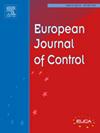Stochastic model predictive control with switched latent force models
IF 2.6
3区 计算机科学
Q2 AUTOMATION & CONTROL SYSTEMS
引用次数: 0
Abstract
Switched latent force models (LFMs) are combinations of a first-principles physical model and a Gaussian process prior, where the driving force of the LFM may switch at certain time points. This allows to use expert knowledge to create an analytical state space model that describes large parts of the system behavior, while deviating parts are modeled using data-based methods. This paper proposes the combination of stochastic model predictive control and switched LFMs by reformulating the Gaussian process priors as linear state space models with additive white Gaussian noise. For this purpose, a stochastic optimization problem is formulated that can be solved by a deterministic approximation of the uncertainty propagation and the chance constraints. The switching points of the LFM introduce further uncertainty to the system that must be considered for the prediction of the state trajectories. Therefore, Gaussian mixture models are used to describe the probability density functions of the predicted states. The computation cost of the approach can be reduced by using a separate disturbance predictor, which allows to formulate the optimization problem of the model predictive controller independently of the internal disturbance states. The performance of the proposed method is illustrated for the control of a building energy system.
具有切换潜在力模型的随机模型预测控制
开关潜力模型(LFMs)是第一原理物理模型和高斯过程先验的结合,其中LFM的驱动力可能在某些时间点发生转换。这允许使用专家知识来创建描述大部分系统行为的分析状态空间模型,同时使用基于数据的方法对偏离部分进行建模。本文通过将高斯过程先验重新表述为加性高斯白噪声的线性状态空间模型,提出了随机模型预测控制与开关LFMs的结合。为此,建立了一个随机优化问题,该问题可以通过不确定性传播和机会约束的确定性近似来解决。LFM的开关点给系统引入了更多的不确定性,这是预测状态轨迹时必须考虑的。因此,使用高斯混合模型来描述预测状态的概率密度函数。该方法通过使用单独的扰动预测器来减少计算量,从而可以独立于内部扰动状态来制定模型预测控制器的优化问题。最后以某建筑能源系统为例,说明了该方法的有效性。
本文章由计算机程序翻译,如有差异,请以英文原文为准。
求助全文
约1分钟内获得全文
求助全文
来源期刊

European Journal of Control
工程技术-自动化与控制系统
CiteScore
5.80
自引率
5.90%
发文量
131
审稿时长
1 months
期刊介绍:
The European Control Association (EUCA) has among its objectives to promote the development of the discipline. Apart from the European Control Conferences, the European Journal of Control is the Association''s main channel for the dissemination of important contributions in the field.
The aim of the Journal is to publish high quality papers on the theory and practice of control and systems engineering.
The scope of the Journal will be wide and cover all aspects of the discipline including methodologies, techniques and applications.
Research in control and systems engineering is necessary to develop new concepts and tools which enhance our understanding and improve our ability to design and implement high performance control systems. Submitted papers should stress the practical motivations and relevance of their results.
The design and implementation of a successful control system requires the use of a range of techniques:
Modelling
Robustness Analysis
Identification
Optimization
Control Law Design
Numerical analysis
Fault Detection, and so on.
 求助内容:
求助内容: 应助结果提醒方式:
应助结果提醒方式:


